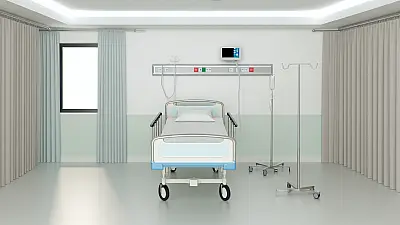HOMER, LA - Presbyterian Village of Homer faced violations during a May 29, 2025 inspection after surveyors found persistent cleanliness issues affecting resident safety, including contaminated air conditioning systems and unsanitary medical equipment in multiple resident rooms.

Contaminated Air Systems Pose Health Risks
Inspectors documented significant problems with air quality control at the 71040 Highway 79 South facility, discovering dirty air conditioning vents with dust buildup and black substances in two resident rooms during multiple visits over two days. The contamination was so apparent that facility leadership acknowledged the problems during the inspection process.
In Resident #3's room, surveyors found air conditioning vents clogged with accumulated dust during observations on both May 27 and May 28. Similarly, Resident #39's room showed black substances coating the air conditioning vents that persisted across three separate inspection visits. The Director of Nursing confirmed these conditions violated facility standards when confronted with the evidence.
Poor air quality in healthcare settings creates significant health risks, particularly for elderly residents who may have compromised immune systems or respiratory conditions. Contaminated HVAC systems can circulate allergens, bacteria, and mold spores throughout living spaces, potentially triggering asthma attacks, respiratory infections, or allergic reactions. Federal regulations require nursing homes to maintain clean air systems specifically because airborne contaminants can cause serious health complications in vulnerable populations.
Unsanitary Medical Equipment Creates Infection Risk
Beyond air quality issues, inspectors discovered contaminated medical equipment directly used for resident care. Resident #3's bed control device, located on the nightstand within easy reach, was found covered with a brown, sticky substance that facility staff acknowledged needed immediate cleaning.
Contaminated medical equipment poses direct infection transmission risks between residents and staff. Bed controls are frequently touched surfaces that residents use multiple times daily to adjust positioning for comfort and medical needs. When these devices harbor unknown substances, they become potential vectors for spreading bacteria, viruses, or other pathogens. Healthcare facilities must maintain strict sanitization protocols for all patient-contact surfaces to prevent healthcare-associated infections.
Industry standards require nursing homes to implement regular cleaning schedules for all medical equipment and frequently touched surfaces. The Centers for Disease Control and Prevention recommends daily disinfection of high-touch surfaces in healthcare settings, with immediate cleaning when visible contamination occurs. Proper infection control protocols should have prevented these conditions from developing or persisting across multiple days.
Safety Hazards in Resident Living Spaces
The inspection also revealed inappropriate storage of medical equipment that created potential safety hazards. Surveyors found a bed rail stored under Resident #3's bed, which the Director of Nursing confirmed should not have been present in that location.
Improperly stored medical equipment can create trip hazards and access problems during emergencies. Bed rails stored on floors pose risks for staff providing care and could impede evacuation procedures if needed. Federal regulations require nursing homes to maintain clear pathways and proper equipment storage to ensure resident safety and staff efficiency during routine care and emergency situations.
Regulatory Standards and Required Improvements
These violations fall under federal regulation F 0584, which mandates that nursing homes provide residents with safe, clean, comfortable, and homelike environments. This regulation encompasses air quality, equipment cleanliness, and hazard-free living spaces as fundamental requirements for acceptable care.
The inspection classified these violations as causing "minimal harm or potential for actual harm," indicating that while no residents experienced immediate injury, the conditions created unnecessary health and safety risks. Federal surveyors determined that few residents were directly affected, but the persistent nature of the problems across multiple rooms suggested broader facility maintenance concerns.
Nursing homes must develop comprehensive environmental maintenance programs that include regular HVAC system cleaning, daily equipment sanitization protocols, and proper medical equipment storage procedures. Staff training programs should emphasize the importance of immediate cleaning when contamination is discovered and regular inspections to prevent problems from developing.
Additional Issues Identified
The inspection focused specifically on environmental cleanliness and safety hazards in resident living areas. Facility leadership acknowledged all identified problems during the survey process, indicating awareness of the deficiencies. The violations affected two residents' rooms but suggested broader systemic issues with cleaning protocols and equipment maintenance throughout the facility.
Federal regulations require nursing homes to maintain infection control programs that prevent the spread of disease through environmental contamination. These programs must include regular cleaning schedules, staff training on proper sanitization techniques, and quality assurance measures to ensure compliance with health and safety standards.
Air quality management in healthcare facilities requires specialized attention because many nursing home residents have chronic respiratory conditions or compromised immune systems that make them particularly vulnerable to airborne contaminants. Facilities must implement regular HVAC maintenance schedules and immediate remediation when contamination is discovered.
The facility must submit a plan of correction addressing these environmental cleanliness violations and demonstrate sustained compliance with federal cleanliness and safety standards. Continued program participation requires approved corrective measures that address both the immediate problems and underlying system failures that allowed these conditions to develop and persist.
Full Inspection Report
The details above represent a summary of key findings. View the complete inspection report for Presbyterian Village of Homer from 2025-05-29 including all violations, facility responses, and corrective action plans.
💬 Join the Discussion
Comments are moderated. Please keep discussions respectful and relevant to nursing home care quality.